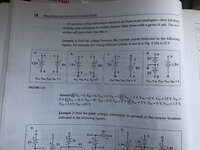Maxmichaels
Newbie
Greetings. I’m working on a example on finding the voltages between the various points. Now if you look at figure 2.13 A) & B) I need to find the voltages between points A & C in both figure examples. Now in Fig.A) the voltages between A & C is zero, but in FigB) the voltage point is 3. Now in one example there is a ground symbol and the other their isn’t. I’m assuming that’s what gives the voltage change but I still don’t understand how the voltages in between A&C is 3 and the other is zero. Help.
